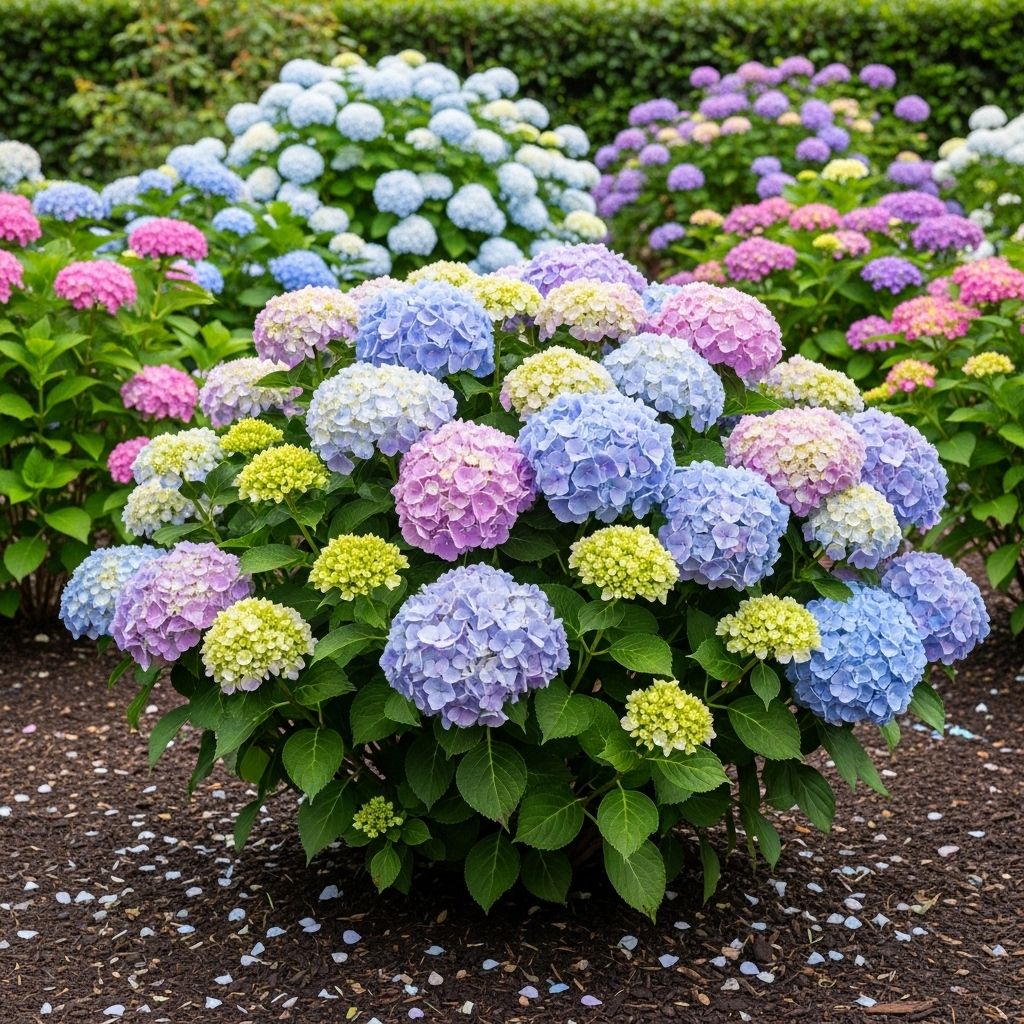How Big Do Hydrangeas Grow: 6 Major Species Size Guide
Understand hydrangea growth habits, mature sizes, and choosing the right variety for your space.

Image: HearthJunction Design Team
Hydrangea Size Guide: How Big Will Your Hydrangeas Grow?
Hydrangeas are prized in gardens worldwide for their exuberant blooms, lush foliage, and the sheer variety of shapes and sizes they offer. One of the most common questions gardeners have is: How big will my hydrangea get? The answer depends greatly on the species and variety you choose. Whether you’re seeking a petite shrub for a small space or a dramatic climbing presence, there’s a hydrangea suited for your needs. This guide breaks down the mature sizes of popular hydrangea species and cultivars, helping you plan your landscape with confidence.
Table of Contents
- Why Hydrangea Size Matters in Garden Planning
- Hydrangea Species Size Chart
- Growth Habits: Shrubs vs. Climbers
- Detailed Look at Each Popular Species
- Dwarf and Compact Hydrangeas for Small Spaces
- What Factors Affect Hydrangea Size?
- Choosing the Right Hydrangea for Your Garden
- Frequently Asked Questions (FAQs)
Why Hydrangea Size Matters in Garden Planning
Understanding the mature size of a hydrangea is essential for placement and long-term garden harmony. Planting a large hydrangea too close to a walkway or foundation can lead to crowding or excessive pruning, which may compromise blooms. Conversely, a too-small shrub might get lost among larger plantings. Knowing each species’ growth habits ensures healthier plants and a more attractive landscape.
Hydrangea Species Size Chart
The most reliable way to anticipate how big your hydrangea will get is by knowing its species and variety. Here is a reference chart summarizing the mature size ranges of six major hydrangea species:
| Scientific Name | Common Name | Height | Width |
|---|---|---|---|
| Hydrangea anomala | Climbing hydrangea | 30-40 feet | 5-6 feet |
| Hydrangea arborescens | Smooth hydrangea | 3-5 feet | 3-5 feet |
| Hydrangea macrophylla | Bigleaf hydrangea | 3-6 feet | 3-6 feet |
| Hydrangea paniculata | Panicle hydrangea | 5-15 feet | 6-12 feet |
| Hydrangea quercifolia | Oakleaf hydrangea | 6-8 feet | 6-8 feet |
| Hydrangea serrata | Mountain hydrangea | 2-4 feet | 2-4 feet |
This chart provides a quick overview to match hydrangea species to your available space.
Growth Habits: Shrubs vs. Climbers
Most hydrangeas are shrubs, with a tidy, rounded growth habit. However, Hydrangea anomala, or climbing hydrangea, is a vigorous vine capable of scaling walls, fences, or trees. When planning your garden, remember climbing hydrangeas require sturdy support structures and can easily reach heights that dwarf other garden features.
- Shrub hydrangeas (macrophylla, paniculata, arborescens, quercifolia, serrata) generally top out between 2 and 15 feet, depending on species and variety.
- Climbing hydrangeas can reach 30–40 feet in height but have a modest width at their base.
Detailed Look at Each Popular Species
Hydrangea anomala (Climbing Hydrangea)
This unique species grows as a vine, reaching 30–40 feet tall with a width of about 5–6 feet. It clings to surfaces with aerial rootlets, producing clusters of creamy white lacecap flowers in early summer. Ideal for covering large walls or trellises, climbing hydrangeas are slow to establish but reward patience with dramatic growth in maturity.
Hydrangea arborescens (Smooth Hydrangea)
Smooth hydrangeas are compact and well-suited to smaller gardens, averaging 3–5 feet tall and wide. Known for varieties like ‘Annabelle’, these hydrangeas bloom on new wood and are resilient even in colder climates. Their domed white flowers are iconic and provide impact without overwhelming tight spaces.
Hydrangea macrophylla (Bigleaf Hydrangea)
Among the most popular hydrangeas, bigleaf hydrangeas attain a size of 3–6 feet tall and wide. They offer versatility for mixed borders, foundation plantings, or as informal hedges. Their flower color changes depending on soil pH—blue in acidic soil and pink in alkaline conditions.
There are also more compact bigleaf varieties suitable for containers and small gardens. For instance:
- Hydrangea macrophylla ‘Pia’: Only 2–3 feet tall and wide, perfect for small spaces and container gardening.
Hydrangea paniculata (Panicle Hydrangea)
Panicle hydrangeas offer some of the widest size ranges, typically growing 5–15 feet tall and 6–12 feet wide. Cultivars like ‘Limelight’ are especially popular for larger hedges or privacy screens due to their upright, bushy growth and prolific cone-shaped flower clusters. Some panicle hydrangeas can reach up to 20 feet if left unpruned.
Hydrangea quercifolia (Oakleaf Hydrangea)
This species, named for its oak-shaped leaves, grows 6–8 feet tall and wide. Oakleaf hydrangeas are prized for their distinctive foliage and cone-like flower clusters that transition from white to pink as they age. These shrubs add texture and seasonal interest to woodland gardens.
Hydrangea serrata (Mountain Hydrangea)
The mountain hydrangea is a smaller cousin to the bigleaf hydrangea, generally staying 2–4 feet tall and wide. It’s well-suited to borders and shaded garden beds, producing delicate lacecap flowers.
Dwarf and Compact Hydrangeas for Small Spaces
Gardeners with limited space can still enjoy hydrangeas by choosing dwarf or compact cultivars. These varieties are bred to retain the classic hydrangea look while staying modestly sized. Examples include:
- Hydrangea macrophylla ‘Pia’: Grows just 2–3 feet tall and wide, with charming pink blooms.
- Hydrangea paniculata ‘Little Lime’: A smaller version of ‘Limelight’, typically 3–5 feet tall.
- Hydrangea arborescens ‘Invincibelle Mini Mauvette’: Stays under 3 feet and offers deep pink flowers.
These diminutive varieties can be used in containers, at the front of borders, or tucked into tight garden corners.
What Factors Affect Hydrangea Size?
While genetics play the primary role in determining the size of a hydrangea, several external factors can impact growth:
- Sun Exposure: Most hydrangeas grow best with morning sun and afternoon shade; panicle hydrangeas tolerate more sun.
- Soil Moisture and Fertility: Well-drained, nutrient-rich soil encourages healthy, robust growth. Hydrangeas are thirsty plants and may wilt if allowed to dry out.
- Pruning: Excessive or improper pruning, especially of old-wood blooming species, can reduce plant size and flowering.
- Climate: Cold winters may limit the size of hydrangeas in northern zones, particularly for less hardy varieties.
- Spacing: Overcrowding restricts air flow and limits mature width and height; always plant hydrangeas with their full size in mind.
Selecting the right hydrangea for your climate and space means less pruning and better flowering in the long run.
Choosing the Right Hydrangea for Your Garden
Deciding which hydrangea to plant depends on both the effect you want and the space you have available. Here’s a quick guide to matching hydrangea size to your design needs:
- For privacy screens or hedges: Choose large panicle or oakleaf hydrangeas (6–15+ feet).
- For foundation plantings and mixed borders: Bigleaf and oakleaf hydrangeas (3–8 feet) are ideal.
- For containers or small gardens: Opt for compact or dwarf varieties (2–3 feet).
- For vertical interest: Climbing hydrangeas (up to 40 feet) can clothe arbors, fences, or large trees.
Always allow for the mature spread and height in your planting layout. Avoid severe pruning, especially of bigleaf types, to ensure abundant blooms.
Frequently Asked Questions (FAQs)
How fast do hydrangeas grow?
Most hydrangeas are moderate to fast growers, averaging about 2 feet of growth per year under optimal conditions. Some climbing hydrangeas start slow but accelerate with age.
Can I keep a large hydrangea small by pruning?
With some species (like panicle and smooth hydrangeas), annual pruning can help control size. However, aggressive pruning of bigleaf and oakleaf hydrangeas may reduce flowering, as many bloom on old wood.
How do I choose a hydrangea for a small garden?
Look for compact cultivars (such as ‘Pia’ or ‘Little Lime’) or species with smaller mature sizes like H. serrata or miniature H. macrophylla. These fit well in containers or limited garden beds.
Do hydrangeas bloom better if they’re bigger?
Not necessarily. Flowering depends on the species, variety, and environmental conditions more than sheer size. Compact hydrangeas can be just as floriferous as their larger relatives.
What if I planted my hydrangea too close to a walkway or building?
If your hydrangea outgrows its space, consider moving it during dormancy (late fall or early spring). Avoid heavy pruning that can impact blooms, especially in bigleaf and oakleaf types.
Are there hydrangeas for shade?
Bigleaf, mountain, and oakleaf hydrangeas tolerate partial shade, particularly in hot climates. Panicle hydrangeas need more sun for best flowering.
Conclusion
Hydrangeas bring a remarkable range of sizes and forms to the garden, from small-space shrubs to towering climbers. By understanding the mature dimensions of your chosen species, you can design a landscape that thrives with minimal intervention. Remember to match each hydrangea to your garden’s soil, light, and spacing for years of easy-care beauty and abundant blooms.
References
- https://www.epicgardening.com/hydrangea-size/
- https://www.epicgardening.com/how-to-grow-hydrangeas/
- https://hydrangea.com/pages/guide-to-growing-bigleaf-hydrangeas
- https://hydrangea.com/blogs/growing-tips/choosing-the-right-hydrangea-for-your-garden
- https://www.thespruce.com/growing-hydrangeas-1402684
Read full bio of Shinta












